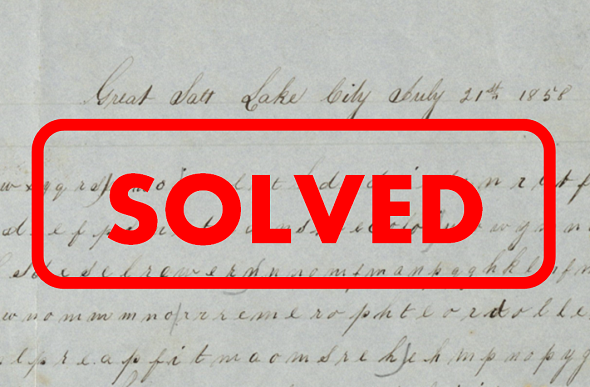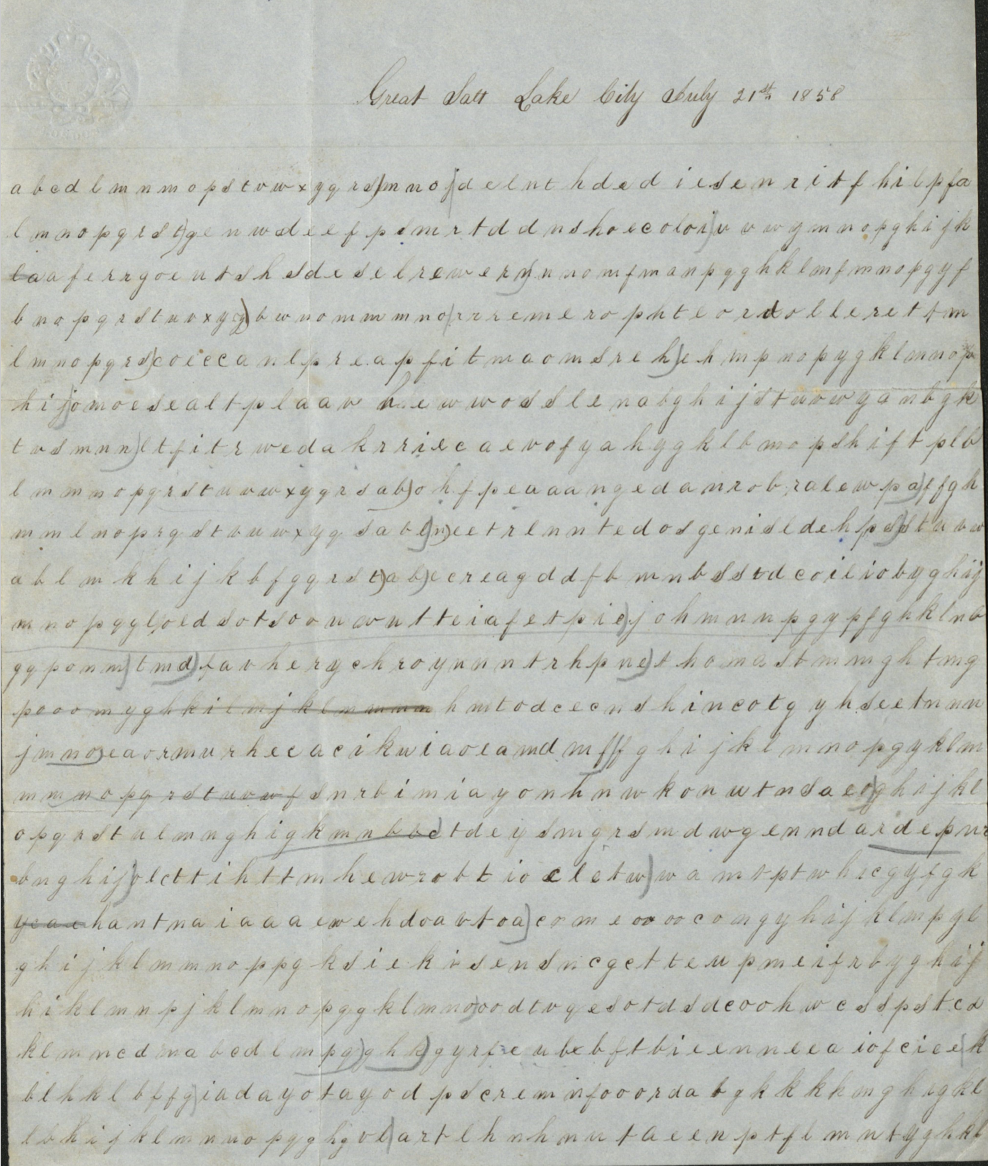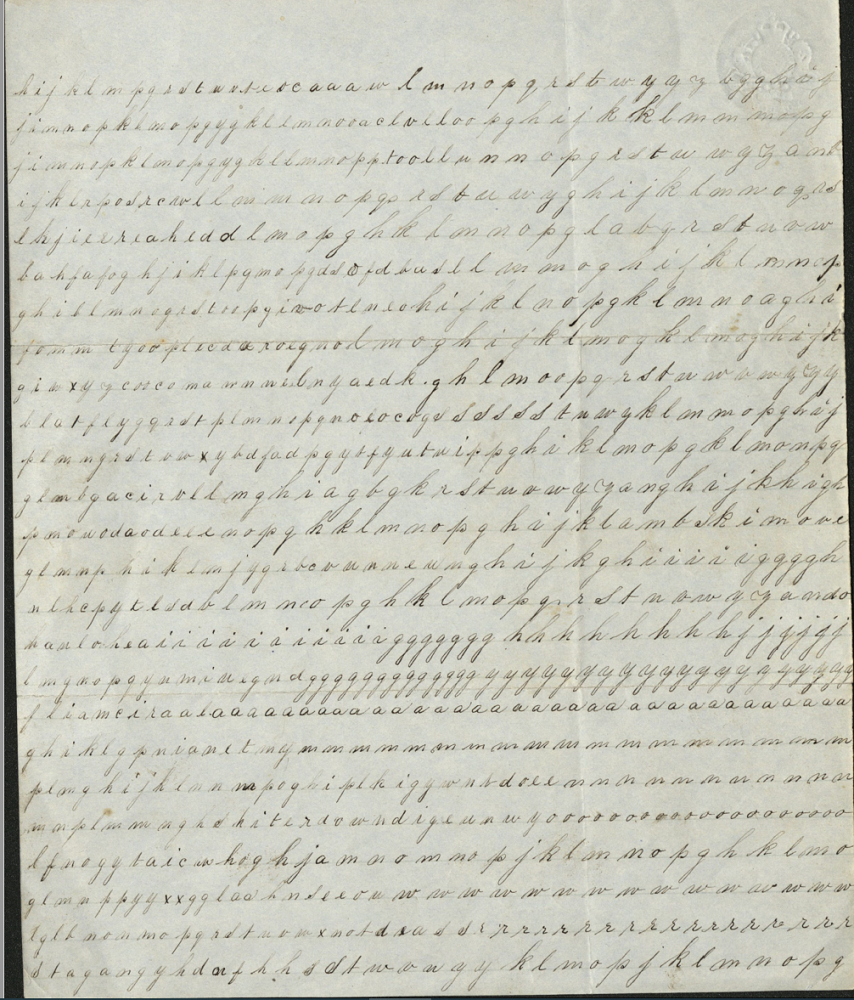Adam Sampson hat den ersten Teil des Utah-Krieg-Kryptogramms aus dem Jahr 1858 dechiffriert. Die zweite Seite ist wahrscheinlich ähnlich verschlüsselt, aber noch ungelöst.
English version (translated with Deepl)
Vor zwei Wochen habe ich über das Utah-Krieg-Kryptogramm gebloggt (englisches Original/deutsche Übersetzung). Dieses wurde mir von dem Historiker Kenneth L. Alford, von der Brigham Young University in Utah (USA) auf Vermittlung von Robert Simpson vom National Cryptologic Museum der NSA zur Verfügung gestellt.
Das Utah-Krieg-Kryptogramm
Das Utah-Krieg-Kryptogramm ist ein zweiseitiger Brief aus dem Jahr 1858, der während des Utah-Kriegs (1857-1858) von Salt Lake City, der heutigen Hauptstadt Utahs, verschickt wurde. Leider weiß man nichts über den Sender, Empfänger oder Inhalt dieses Briefs.
Der beagte Brief befindet sich seit 50 Jahren in Besitz der Universität Yale, die es seinerzeit einem Antiquar abkaufte. Das Kryptogramm war bis vor kurzem unkatalogisiert. Der derzeitige Yale-Kurator Bill MacKinnon ließ Alford, einem der führenden Experten für den Utah-Krieg, eine Kopie zukommen.
Die folgenden Scans zeigen die beiden Seiten des Kryptogramms:
Adam Sampson, von dem noch die Rede sein wird, hat eine Transkription erstellt:
abcdlmnmopstvwxyqrs)mnoj)@delnthdediesenribfhilpfa
lmnopqsdt)g@enwdeefpdmrtddnshorcoloi)vvwymnopqhijk
ba)@aferrgoentshadedelrewern)nomfmanpqqhklmfmnopqyf
bnopqrstuvxyy)bwnommmno)@rrremerophteordsllerettm
lmnopqsd)@coecanlpreapfitmaomsreh)ehmpnopygklmnop
hij)@omoesealtplaanhewwosslenabghijstwvwgambgk
tvsmmn)@ltfitrwedakrriecaenofyahygklbmopshiftplb
lmmnopqrstuvwxyqrdab)@ohfpeaaangedamrobralewpa)ffgh
mmmlnoprqsttuwxyqsabb)@neetrlnntedosgenisldehps)stabc
ahlmkhijkbfgqrst)ab)@ecreagddfbmnbsstdcoiliobygdij
mnopqy@l)oedsotsoouwutteiafetpie)johmnnpgypfghklnb
qyponm)@tmd)favherychroynnntrhpne)thomastmmghfmg
pooomygjkilmjklmmmm)@hmtodcecnshincotgyhseetnnn
jmmo)@eaormurhecacikuiaoeamdmf)fghijklmnopqyklm
mmnopqrstuvwf)@snrbimiayonhnwkonwtnsaeo)ghijkl
opqrstulmnghijkmntbe)@tdeysmgrsmdwgenndaidepnr
dnghij)@olcttihttmhewrobtiocletw)wamtptwhieggfgh
y@cae)hantmaiaaaewehdoavtoa)ermeoooocomgyhikklmpgh
ghijklmmnoppg@ksiekisensncgctteupmeifrbyghij
hiklmnpjklmnopqgklmno)oo@dtvqesotdsdcoohwcsspstcd
klmnedmabedlmpq)ghk)gy@rfeubbftbieenneeaiofciee)d
blhklbffg)@iadayotayodpscremnfooordabgkkkkongkigkl
lbhijklmnnopqghj@vl)artlhnhnutaeenptflmntyghkl
hijklmpqrstuv)seocaaaw)lmnopqrstwyqzbggrsxj
jimmopklmopgygkllmmo)oaclvlloo)pghijkklmmmopg
jimmopklmopgygkllmmopp)toollu)nnopqrstwwyzamt
ijkl)rposrcw)llmmmopqrstuwyghijklmnoqrs
lhj)ieereahedd)lmopqhklmnopqlabqrstnow
bahfafoghjihlpgmopg)dsofdbasl)lmmoqhijklmnop *
ghillmnoqrstuvpg)irotlneo)hijklnopqklmnoaghi *
fommtgooplec)daroegno)lmoqhijklmoqklmoghijk *
giwxyzcoocomamnm)ebnyaedk)ghlmoopqrstuwvwyzy
blarflygqrstplmnopqno)eocogsss)ssstuwyklmnopqbij *
plmngrdtvwxybdfadpqy)sfyutuip)pqhiklmopqklmonpq
gl)mbgacirv)llmqhiagbakrstuowyyanghijkkigh **
pmouodaode)eenopqhklmnopqhijklnmbekimooe
glmnphiklmjyg)rbovnnneun)ghijkghiiiiiggggh
nlhcpyclsdbl)mncopghklmopqrstnowyyamdo
k)aulohea)iiiiiiiiiiiggggggghhhhhhhhjjjjjj
lmgnopqy)nmiuegnd)gggggggggggggyyyyyyyyyyyyyyyyyyyy
f)liamciraal)aaaaaaaaaaaaaaaaaaaaaaaaaaaaaaaaaa
ghi)klgpnianetmy)mmmmmmmmmmmmmmmmmm
plmghijklmnmpoghi)plkigywnsdoee)mmmmmmmmmmm
mmplmmmghskiterdowndigeunwyoooooooooooooooooooo
lfnoyytaicwho)ghjamnommopjklmmopghklmo
glmnppyyxxgglaa)hnseeou)wwwwwwwwwwwwwww
lgtbnonmopqrstuvwx)notdsass)rrrrrrrrrrrrrrrrrr
stagangyhdnf)hhsstwvwyyklmopjklmnopq
Besonderheiten
Schon ein Blick auf die erste Zeile zeigt eine Besonderheit:
Diese Zeile beginnt mit ABCDLMNMOPSTVWXYG, also mit Buchstaben in alphabetischer Reihenfolge. Meine Vermutung war, dass der Sender den ersten Buchstaben im Klartext mit A, den zweiten mit B, den dritten mit C usw. verschlüsselt hat. Allerdings hätte dies bedeutet, dass es in den ersten 17 Buchstaben nur eine Wiederholung (das M) gegeben hätte, was sehr unwahrscheinlich ist.
Ungewöhnlich sind auch die vielen Buchstaben-Wiederholungen auf der zweiten Seite.
Meine Vermutung war, dass damit Zahlen verschlüsselt wurden (beispielsweise könnten 17 As in Folge für die Zahl 17 stehen).
Nach meinem Blog-Artikel tat sich erst einmal wenig. Es gab nur einen Kommentar. Am 12. Dezember stellte ich das Utah-Krieg-Kryptogramm in meinem Online-Vortrag über ungelöste Verschlüsselungen (zusammen mit Elonka Dunin, der Koautorin meines aktuellen Buchs) im ICCH-Forum vor. Es gab interessante Diskussionen dazu, aber keiner kam auf die Lösung.
ICCH-Vorträge (sie werden auf Englisch gehalten) finden übrigens alle zwei Wochen samstags statt und sind meist sehr spannend. Es gibt leider keine Webseite dazu, und die Teilnahme-Links werden bewusst nicht im Internet veröffentlicht. Trotzdem ist jeder willkommen und die Teilnahme kostenlos. Wer dabei sein will, kann mir gerne eine Mail schicken. Einziger Nachteil: Die Vorträge überschneiden sich mit der Sportschau.
Die (noch nicht vollständige) Lösung
Den ICCH-Vortrag hat sich auch der Krypto-Experte Adam Sampson angehört (ich glaube, er ist Brite, weiß es aber nicht genau). Vor ein paar Tagen hat Adam die Lösung der ersten Seite des Utah-Kryptogramms auf der zum ICCH-Forum gehörenden Mailing-Liste veröffentlicht. Er schrieb:
I’d spotted that on both pages, the runs of alphabetic sequences and
repeated characters don’t continue across line breaks, which suggested
that the line structure was important and the runs were probably filler.
There are also some pencil marks that look like they’re dividing the
lines into sections. This turned out to be right (although not all the pencil marks are
correct!): each line has a variable amount of junk at the start and the
end, and on the first page there are 24 meaningful characters on each
line.
Mit anderen Worten: Die ungewöhnlichen Buchstabenfolgen wie “abcdlmnmopstvwxyg” sind nur Füllmaterial. Pro Zeile auf der ersten Seite zählen nur 24 Buchstaben, der Rest ist bedeutungslos. In der ersten Zeile sind die Buchstaben “delnthdediesenribfhilpfa” relevant. In der folgenden Transkription der ersten Seite ist das Füllmaterial weggelassen:
delnthdediesenribfhilpfa enwdeefpdmrtddnshorcoloi aferrgoentshadedelrewern rrremerophteordsllerettm coecanlpreapfitmaomsrehe omoesealtplaanhewwosslen ltfitrwedakrriecaenofyah ohfpeaaangedamrobralewpa neetrlnntedosgenisldehps ecreagddfbmnbsstdcoiliob loedsotsoouwutteiafetpie tmdfavherychroynnntrhpne hmtodcecnshincotgyhseetn eaormurhecacikuiaoeamdmf snrbimiayonhnwkonwtnsaeo tdeysmgrsmdwgenndaidepnr olcttihttmhewrobtiocletw caehantmaiaaaewehdoavtoa ksiekisensncgctteupmeifr dtvqesotdsdcoohwcsspstcd rfeubbftbieenneeaiofciee iadayotayodpscremnfooord vlartlhnhnutaeenptflmnty
Jetzt kann man den Klartext spaltenweise auslesen:
Dear Colonel,
The stock driven from the command last fall were offered to, received
and receipted for by the quartermaster, a sad mistake by the General.
Gov. Cummin is bold for law and the rights of the people, and
Sec. Hartmett and Suprtdnt. Forney stand by him. The pageboys
commissioners talked much and handed us the pardon, which we accepted as
far as burning wagons and driving stock were concerned. The rest you
know. There is some contention between the law-abiding and the camp
followers. Can you aid us in the removal of the troops? Officers,
soldiers and camp followers feel themselves completely whipped. A
petition for the appointment of certain men has been forwarded y
Es handelt sich also um eine Transpositions-Chiffre. Gratulation an Adam Sampson!! Das war eine tolle Codeknacker-Leistung!
Mit dem Inhalt des Klartexts kann ich leider wenig anfangen, da ich die geschichtlichen Hintergründe nicht kenne. Ich vermute aber, dass Ken Alford etwas dazu sagen kann.
Offene Fragen
Adam Sampson hat sich natürlich auch die zweite Seite des Briefs angeschaut, allerdings bisher ohne Erfolg. Vermutlich ist der Klartext in acht Spalten kodiert, der Rest ist Füllmaterial.
Findet ein Leser mehr heraus? Adam hat hier ein Python-Programm veröffentlicht – vielleicht hilft dies jemandem.
Vielen Dank noch einmal an Ken Alford für das Kryptogramm und an Adam Sampson für die Lösung!
Follow @KlausSchmeh
Further reading: Two Pigpen postcards from Ohio (1)
Linkedin: https://www.linkedin.com/groups/13501820
Facebook: https://www.facebook.com/groups/763282653806483/






Kommentare (11)